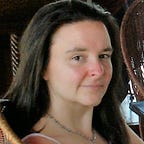Report from FemCon
by Anna Simas
As a graduate student at the University of Washington, I was fortunate enough to be able to participate in a micro-seminar offered in anticipation of FemCon VII and run by two of the conference organizers, Sarah Levin-Richardson and Kathryn Topper. The micro-seminar, called “Feminism and Visual Theories,” focused on familiarizing us with the theory behind the theme of FemCon VII. In the first week of the micro-seminar, we prepared for the conference by discussing some of the seminal works of gaze theory, including Laura Mulvey’s “Visual Pleasure and Narrative Cinema” and bell hooks’ “The Oppositional Gaze.” The readings covered in the micro-seminar proved essential for understanding and engaging with many of the papers presented at the conference.
In the second and third weeks of the micro-seminar, we discussed how gaze theory and feminist theory have influenced our interpretations of classical material. In the second week, we talked about the influence of gaze theory and feminist theory on analysis of Greek literature and art. In the third week, we focused on applications of gaze theory and feminist theory to Roman culture. We had incredibly thought-provoking discussions during these sessions, which were enriched by the diverse backgrounds of the class participants, many of whom were students in fields outside of Classics.
FemCon took place on the weekend following the third week of the micro-seminar, and all participants in the class were required to attend at least one session of papers. I attended the panel “Eyeing Ovid,” where E. Del Chrol, Ellen Cole Lee, and Sanjaya Thakur gave talks about viewing and vision in the poetry of Ovid. The readings that I had done for the micro-seminar proved particularly useful for my understanding of Del Chrol’s paper, which discussed erotics, the evil eye, and the emission theory of vision. According to emission theory, the eye emits particles that physically touch the object of the gaze; in an erotic context, the particles then return to the viewer’s eye, causing the viewer to fall in love with the viewed person. As Del Chrol pointed out, this is an interesting inversion of the typical active/viewer and passive/viewed dichotomy. Because I was not familiar with emission theory prior to Del Chrol’s talk, I found that the readings on gaze theory that I’d encountered in the micro-seminar were particularly useful in helping me understand the theory behind Del Chrol’s argument.
Overall, the micro-seminar and its readings greatly increased my understanding and enjoyment of the talks given at the conference. In addition, the micro-seminar allowed UW students from fields outside of Classics to enjoy and interact with Classical material. Many students of the micro-seminar came from departments like English, Drama, or Art History, and each of them brought a unique and helpful perspective to our discussions of applications of theory to Classical art and literature. Interdisciplinary collaboration is always a great benefit for everyone involved; this was certainly the case for the students of the micro-seminar who attended FemCon!
